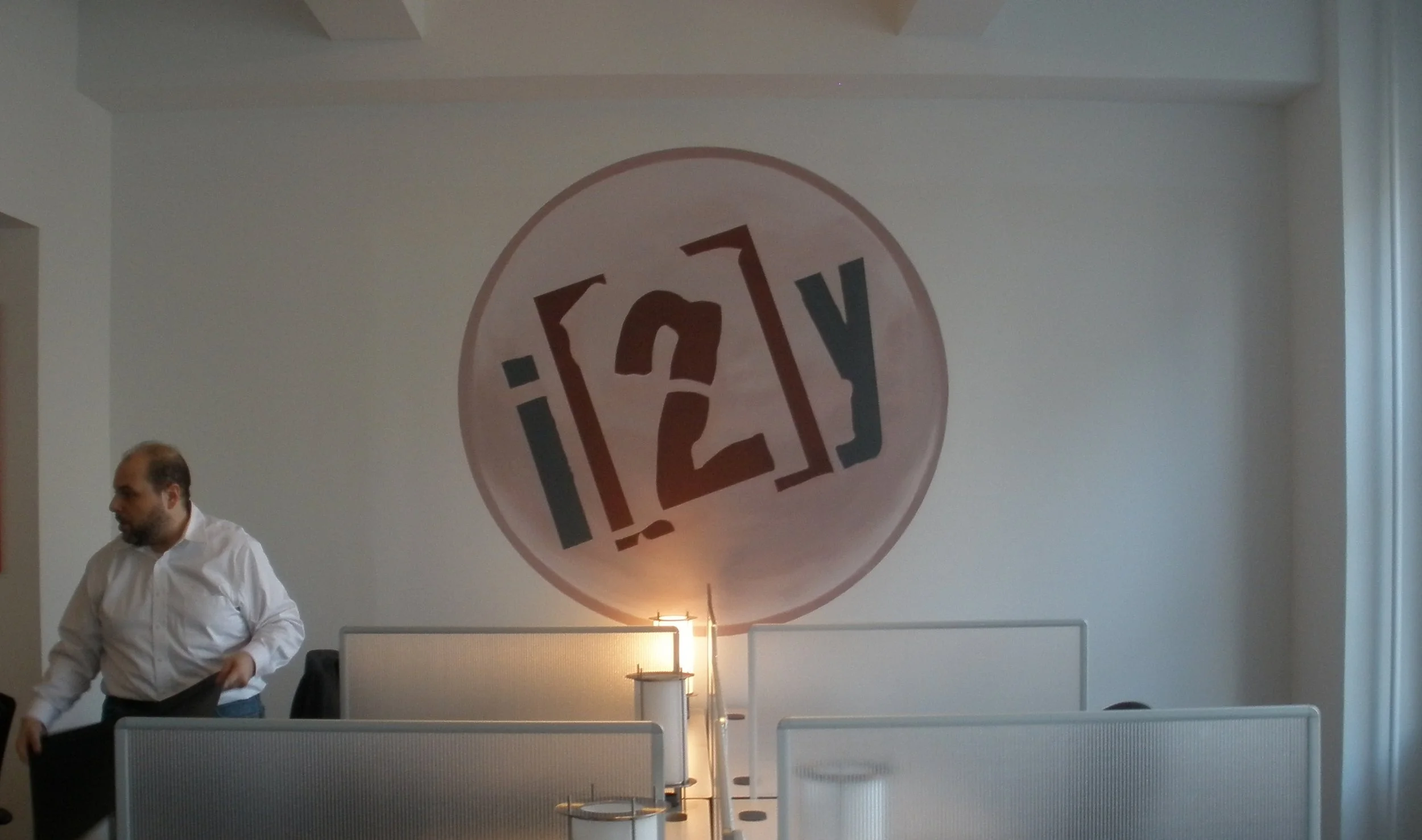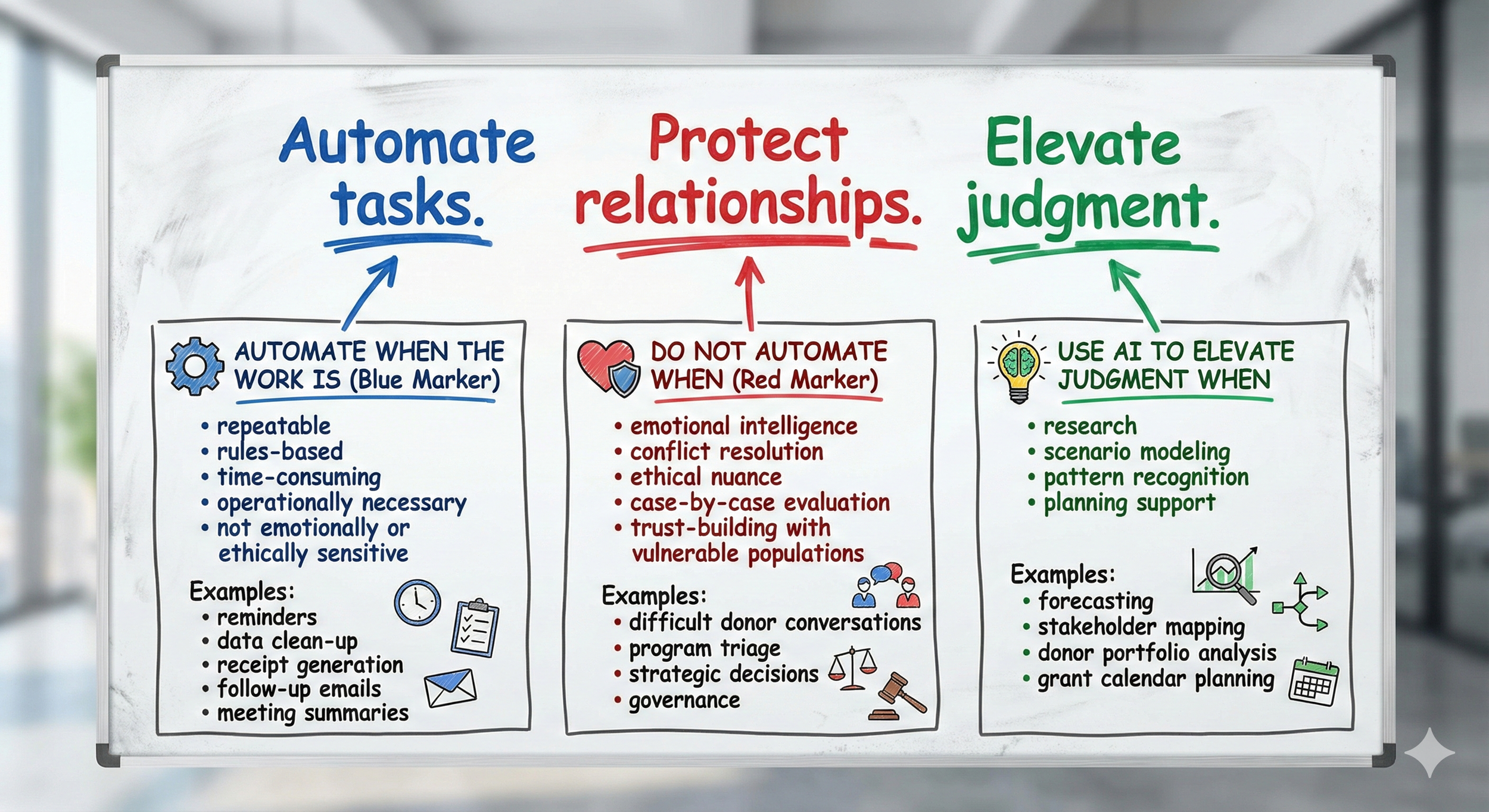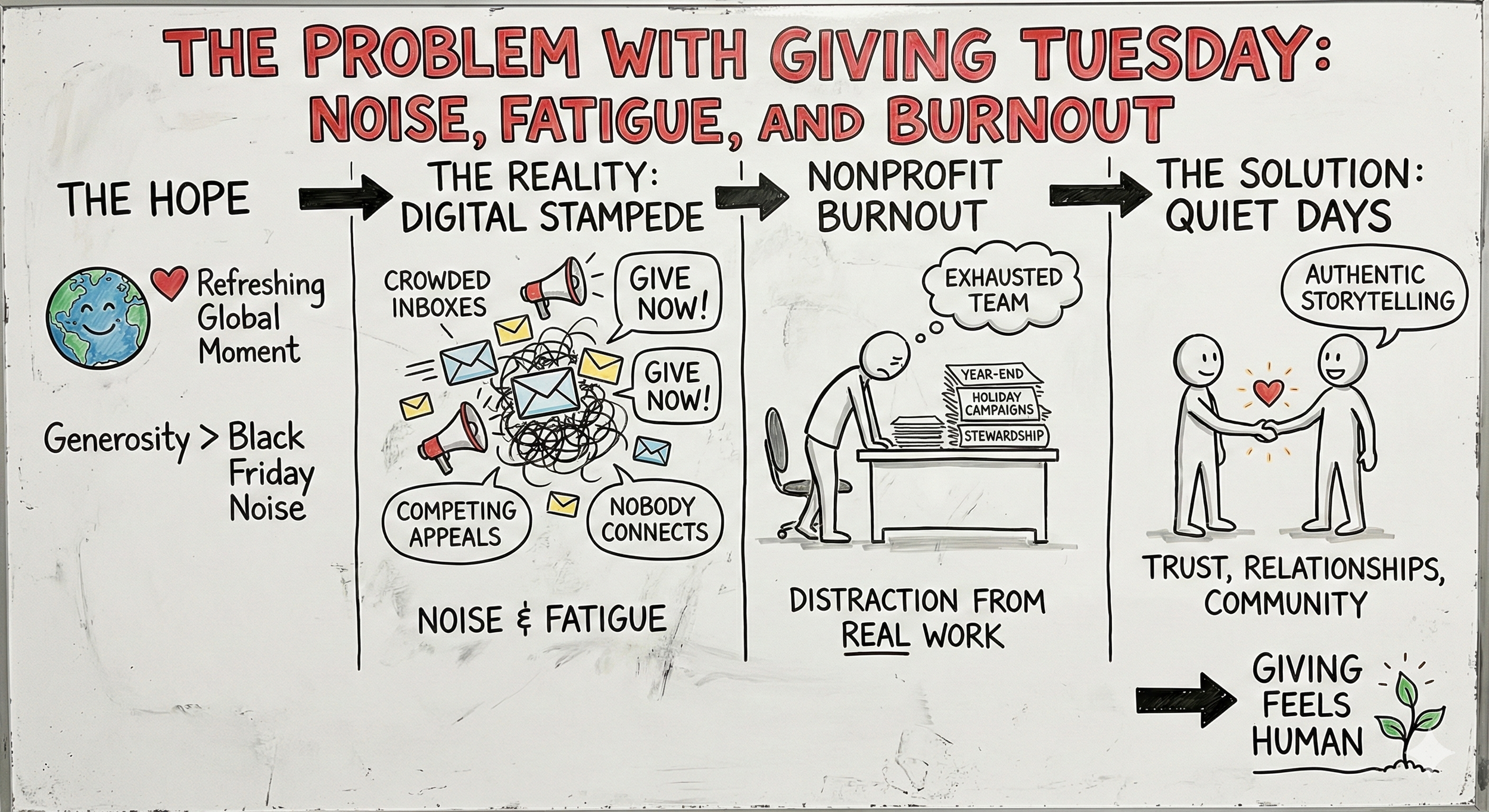Insights on Building Mission-Driven Organizations
Practical lessons from 15+ years of leadership across nonprofits, real estate, and healthtech. Topics include AI implementation, nonprofit operations, business systems, and what it takes to scale organizations without losing your mission.

Kenny’s 2026 Tech Stack
People often ask what tools I rely on day to day. The honest answer is that my stack is less about novelty and more about reliability. I care far more about whether something fits into my operating rhythm than whether it is the newest thing on Product Hunt.
This is a snapshot of the tools I’m using right now, how they show up in my work, and where I’m seeing real value versus diminishing returns.

What I’m Too Young For This! Cancer Foundation Really Was
Before it was Stupid Cancer.
Before it had a national summit, a recognizable brand, or a seat at policy tables.
Before the language of AYA oncology entered the mainstream.
I’m Too Young For This! was a refusal.
It was a refusal to accept that young adults with cancer should quietly disappear into the space between pediatric and adult care. A refusal to accept isolation as normal. A refusal to believe that survivorship only counted if you were old enough to be taken seriously.

Grabbing Life by the Balls: A Conversation on Cancer, Work, and Building Things That Last
I recently joined Mallet & Michelle for a conversation that ended up covering a lot more than testicular cancer, even though that is where my story usually starts. What made this one different was how naturally it moved between personal history, work, leadership, and the experiences that quietly shape how we show up in the world.
My connection to testicular cancer is personal. When I was a high school senior, my dad was diagnosed. There was no long lead-up or time to process it emotionally. He found a lump, saw a doctor, and within days was in surgery. That summer, which was supposed to be about graduation and getting ready for college, turned into chemo appointments and hospital visits. Like a lot of families who go through cancer, we figured things out as we went. You do what needs to be done and worry about the rest later.

My Year in AI
This year was the first time artificial intelligence stopped feeling like a tool and started feeling like a partner. It was the first time I saw it not as something we bolt onto existing workflows but as something capable of reorganizing how my organizations think, operate, and scale. I entered the year curious. I am leaving it with a clear sense that my companies, my work, and even my personal operating rhythm have fundamentally changed.
My AI journey has been shaped by the fact that I work across different sectors. I run a real estate company that relies on operational consistency. I lead a national health nonprofit where trust and empathy matter more than efficiency. I collaborate on Gryt Health, a health tech organization focused on improving the patient experience in oncology. These roles should be worlds apart, yet AI made them feel connected. The same capabilities that helped a cancer survivor receive better follow-up also helped a Firmspace member get faster service. The common thread was not the technology itself. It was the intentional design of systems that amplified human work rather than replaced it.

How AI Can Strengthen Nonprofit Operations Without Replacing Human Relationship Work
When I first started at Stupid Cancer, I took the CEO’s Outlook contacts from years of his personal advocacy work and manually entered every single one into SugarCRM. Line by line. Name, email, organization, phone number. Copy, paste, save. It took hours. And none of it felt connected to the mission. It was my first real glimpse into something every nonprofit eventually discovers. The work you care about is always competing with the work you can’t avoid.
For years, that kind of administrative drag was just part of the job. You powered through it. You made peace with the backlog. You assumed the operational chaos was permanent. The calls you didn’t return. The follow ups you meant to send. The donor updates that slipped because your CRM was a mess. It was constant.

Listening to Your Emails and Messages Makes You a Better Communicator
For most of my career, I’ve moved fast. I’ve relied on instinct, momentum, and the ability to figure things out on the fly. In small teams or early-stage environments, that approach works. You don’t have to explain every step or provide perfect clarity—you just build, adjust, and keep going. But as the organizations around me grew, the cost of unclear communication started to show up in ways I couldn’t ignore. I’d send a message that made perfect sense in my head, only to realize later it didn’t land the way I intended. Or I’d fire something off quickly and it would accidentally create more work or confusion for someone else. That’s when I started using a small Mac feature that unexpectedly became one of the most effective productivity habits I’ve ever built: Speak Selection.

The Problem With Giving Tuesday: Noise, Fatigue, And Burnout
I remember when Giving Tuesday first appeared on the scene. Back then I was at Stupid Cancer, running operations, building digital infrastructure, and trying to hold together a national movement with passion, long nights, and whatever technology we could afford. The idea of Giving Tuesday felt refreshing. A global moment where generosity could rise above the noise of Black Friday and Cyber Monday. It felt like the kind of thing a young nonprofit ecosystem needed.
But even in those early years, something became obvious. The noise did not disappear. It got louder.

I Don’t Give Keynotes. I Share Field Notes.
Someone asked me recently why I am not a public speaker on a more regular basis. They had listened to me on a podcast, seen me moderate sessions at Stupid Cancer events, and watched me speak at Testicular Cancer Foundation gatherings. Their assumption was that speaking was something I pursued. It is not.
I do not speak on public stages very often. Not because I avoid it, but because most of my career has been spent building organizations, communities, and operational systems rather than talking about them from a podium. I have never thought of myself as a professional speaker. I do not go on a speaking circuit. I do not sell ideas from the stage. But when the work required it, I have spoken. And those have always been the meaningful moments.
How I Built a Google Knowledge Panel in One Day
If you have ever Googled yourself and found incomplete or incorrect information, you know what it feels like to have your digital identity misrepresented. Especially for entrepreneurs, authors, executives, and professionals, a Google Knowledge Panel is not a vanity feature. It is a core pillar of credibility, discoverability, and digital authority. It is also one of the most trusted sources used by search engines, AI models, and voice assistants.
Last week, I completed a full Google Knowledge Panel optimization project for my personal entity. I created a structured Wikidata entry, updated my website’s schema, connected my Google Knowledge Graph ID, fixed disambiguation issues, and built an identity verification loop across Google, Wikidata, and my site. And I completed it in one day.
When the Origin Story No Longer Represents the Organization
There is a moment in the life of a maturing organization when the nostalgic version of how it all started no longer reflects the organization that exists today. What begins as a small group around a table becomes a disciplined organization with governance, systems, brand standards, and culture. Along the way, roles evolve. Titles change. Some contributors step away. Others step fully into the responsibilities required for scale. What used to be a story becomes an enterprise.
As that evolution happens, leaders gain a new responsibility. It is to protect the accuracy of the organization’s history while ensuring that history does not become confused with identity. Someone may have been present in the beginning, but that does not mean they shaped what the organization ultimately became.
Contribution is not the same as governance. Proximity is not the same as leadership. Being part of the early story is not the same as shaping the current one.
Should AI Get a Cover Credit?
Here's a question I've been wrestling with: if I use Claude to help me write a book, should that go on the cover?
Not buried in the acknowledgments between my coffee maker and my dog. On the cover. Like those black-and-white Parental Advisory stickers that started appearing on albums in the 90s — a warning label signaling that something inside might be... different.
Claude AI for Writing: The Complete Guide for Authors and Content Creators
The rise of AI writing tools has changed how we think about authorship. For most creators, the challenge isn’t whether AI can write—it’s how to make it work with your process, not against it.
After years of building organizations and publishing books, I’ve found that Claude AI (especially the 3.5 Sonnet model) is the first system that feels less like a generator and more like a collaborator. It doesn’t try to be the author—it helps you become a better one.
This guide distills how I use Claude to write and edit long-form projects like The Accidental Nonprofiteer and Mission-Driven Ecommerce. Whether you’re a novelist, nonfiction writer, or content creator, you’ll see how to integrate AI into your workflow without losing your voice or authenticity.
Why I'm Investing in Structured Data (And Why You Should Care About Schema Markup)
This week, I took a hard look at the structured data on my website. Not because I'm chasing some technical SEO checklist, but because I realized something important: if I don't tell search engines who I am, they'll figure it out on their own. And when there are two other people with my exact name competing for the same search results, I can't afford to leave that interpretation up to chance.
Structured data, specifically schema markup, is how you give search engines the context they need to understand your identity. It's not about gaming the system. It's about clarity. When someone searches for Kenny Kane, I want Google to know exactly which one I am. The CEO and author in Austin, not the comedian in Los Angeles or the rapper in Memphis.
I Asked Lindy AI to Write My Wikipedia Page
This week I asked Lindy AI to generate a Wikipedia page about me. Not to publish on Wikipedia itself, just to see what it could create from my public footprint.
The result looked surprisingly real. It built a full article with an infobox, clean sections, and a references list that linked to my site, Forbes articles, and even my books. It read like something that could actually live on Wikipedia.
Initially, it wasn’t perfect. A few dates were wrong and some sources were thin, but that was the value. It showed me what the internet already says about me, how consistent my story is, and where I could improve the trail of verified information behind it.
I used it as a checklist to tighten my own online narrative. If an AI can build a convincing profile in seconds, it’s a good reminder that your digital presence is always being written, whether you’re involved or not.
Beyond the Platform: What GoFundMe Taught Us About Nonprofit Tech Ownership
This week, headlines broke that GoFundMe quietly created fundraising pages for 1.4 million nonprofits across the U.S. Most of those organizations had no idea the pages even existed. It’s a perfect, if uncomfortable, illustration of where nonprofits stand today in the digital landscape. Tech platforms are moving faster than most organizations can keep up with, and if you don’t actively manage your digital presence, someone else will.
That’s not a dig at GoFundMe. Their intent was to make it easier for donors to find and give to nonprofits. But it highlights a bigger truth: digital transformation isn’t optional anymore. It’s not just about adopting tools; it’s about owning your identity, your data, and your narrative in an increasingly automated world.
